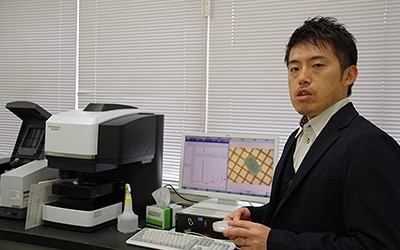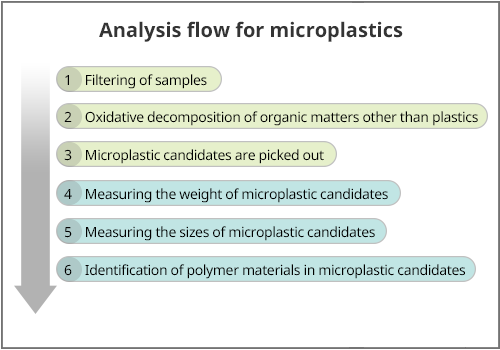
Microplastics
Tokyo University of Science

INDUSTRY
Microplastics
KEYWORD
INTRODUCTION SERVICE&PRODUCTS
Plastic waste including microplastics (< 5.0mm) flows out to sea from the land via rivers, but it is unclear just how much levels of microplastic pollution have progressed in Japanese rivers. We talked to Tomoya Kataoka from the Tokyo University of Science, one of the few Japanese scientists who has been investigating microplastic pollution in rivers. He has been using a Shimadzu FT-IR (Fourier transform infra-red spectrometer) for the analysis of microplastics since 2016, and also both FT-IR and IR microscopy for the analysis of smaller samples since 2019.

Asst. Prof. Tomoya Kataoka
*Affiliates and titles of the interviewee are current as of the time of reporting.
Tokyo University of Science
URL
https://www.tus.ac.jp/en/

Please tell us about your research.
We have sampled microplastics in 70 Japanese rivers at 90 sites since August 2015, and found 4.3 microplastic pieces per 1 m3 of river water on average. In addition, microplastic pollution is increased in polluted rivers flowing near urban areas with high human activity.

Many microplastics are generated mainly on the land by fragmenting due to photodegradation by UV sunlight and thermal degradation on the ground. These smaller plastic pieces are then swept out to the rivers by wind and rain, and finally released into the sea. Once they flow out into the sea, it is extremely difficult to remove them. Consequently, microplastics will go on increasing in the oceans because plastics can take a long time to decompose in a marine environment. Investigating plastic pollution in rivers near to potential sources of microplastics is one way to prevent these microplastics entering the rivers and seas. Our results will also help us to identify the sources.

How do you collect the microplastics from rivers?
We hang a 0.3-mm mesh plankton net from a bridge to the surface of the river for 5-10 minutes. We collect the samples and then bring back them to the laboratory for analysis.
We identify and quantify microplastics through 6 analysis steps. Microplastic candidates are picked out from the samples by eye, and then their size and weight are measured. Finally, polymer materials are identified through FT-IR analysis.
What reasons did you have for choosing Shimadzu instruments?
Before we were using a different company’s equipment, but now we have a Shimadzu FT-IR (IRAffinity-1S). When we were considering the purchase, the most important points were to be able to measure the IR spectrum with high resolution and to have installed the “Thermal-Damaged Plastics Library”, which seemed as if it would be useful for identifying microplastics.

FT-IR and infra-red microscope

IR spectrum (left) and photo of sample measurements (right)
Please tell us about your latest research.
Since 2017 we have been investigating the vertical distribution of microplastics. Previously we collected microplastics only on the surface, but in this study we collected microplastics at 8 levels by hanging 8 nets from a bridge. We found a significant high concentration of microplastics near the river bed and at the surface, but these depend on the flow conditions.
This indicates that microplastics settled at the bottom may be caught up in turbulent flow conditions. In addition, microplastic concentrations vary according to many factors, such as dimension of river cross-section, land use, population density, seasonal changes as well as flow conditions. We will continue the microplastic research in Japanese rivers, and finally quantify the transport of microplastic emission from Japanese rivers
What are your expectations of Shimadzu in the future?
When identifying plastics by Attenuated Total Reflection (ATR) using FT-IR, the sample has to be put under pressure, and is sometimes deformed or broken down in the process. This is why we use it as the final step in identifying the polymer materials in plastic candidates. We have to complete measuring the size and weight of all microplastic candidates beforehand. But if we can measure their weight and size after identifying polymer materials, we can analyse microplastics more efficiently. So I expect Shimadzu to develop an instrument or system that can accurately identify polymer materials without pressing the samples, and also automatically measure weight and size of plastic particles.
We are very glad to hear that the IRAffinity-1S and Thermal- Damaged Plastics Library have been of use in these studies. We are continually developing new products to contribute to environmental research. Thank you for this valuable insight into your work.